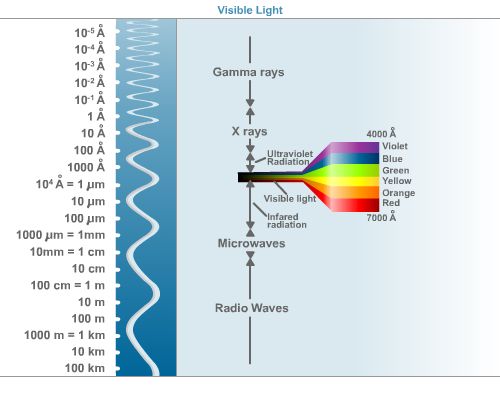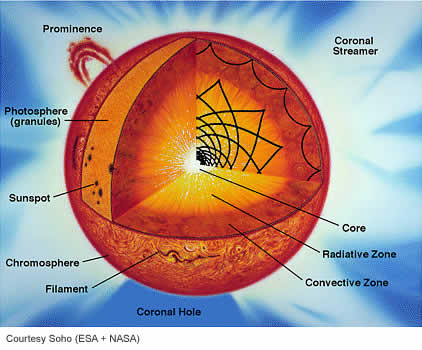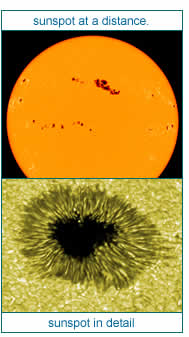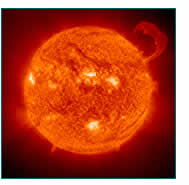|
 Dr. Z, an internationally famous astrophysicist, studies the sun.
His knowledge is reflected in many scientific papers. He is passionate about enlightening younger students about
the sun. Presented here are excerpts from Ms. Moon's interview with Dr. Z. For training purposes, important
terminology is in boldface type. Dr. Z, an internationally famous astrophysicist, studies the sun.
His knowledge is reflected in many scientific papers. He is passionate about enlightening younger students about
the sun. Presented here are excerpts from Ms. Moon's interview with Dr. Z. For training purposes, important
terminology is in boldface type.
When he is not in his laboratory working with students, Dr. Z studies the sun at home. His home is a large
geodesic dome (a light-weight dome structure) that squats high on a granite crag. It is nestled in mountain
laurel and ponderosa pine. You can reach it by following a twisting, gravel trail up the side of a steep slope.
Long, skinny, wide, short and round telescopes poke through windows and the roof. The furniture is simple, bright,
and colorful--just the right kind of setting to unravel the sun's twisted mysteries.
Ms. Moon is a high school science teacher whose interest in astronomy and love for her students has led her to Dr.
Z's mountain home.
Dr.Z: Welcome, Ms. Moon.
Ms. Moon: Thank you, sir, for inviting me.
Dr.Z: Before we sit down, can I offer you something to drink?
Ms. Moon: I'd love some iced tea.
Dr.Z: A good, cold drink for talking about a hot topic. Here you go. Please make yourself comfortable. Now, how can I assist you?
Ms. Moon: I need help warming my students to the sun.
Dr.Z: How wonderful! Would you like the full or the eclipsed version?
Ms. Moon: I'd like just the right amount of information to make my students curious.
Dr.Z: Excellent. Most students prefer a tan to a sunburn.
Ms. Moon: What do scientists know for certain about the sun?
Dr.Z: They know quite a bit, with even more being revealed every day. Let me share the bare facts of what is known at this time. First of all, the sun is comprised of atoms of hydrogen and helium in various forms and in constant change due to the intense levels of heat and energy. The core, which is the very center of the sun and the source of the sunís tremendous heat, makes up 25% of the sun's entire mass. Inside the core is one gigantic, on-going thermonuclear explosion involving two important concepts central to nuclear physics: fusion and fission. Fusion is the bonding of two nuclei. If we could capture the solar energy created by the fusion in the sun's core and tame it here on Earth, we could meet the energy needs of every nation for years to come. In our nuclear power plants, we use fission to generate energy. Fission is the process of splitting the protons and neutrons in the nucleus of an atom. It is a messy process that produces radioactive waste, primarily in the form of gamma rays. Guess how long it takes these little gamma rays to travel from the sun's core to the outer layers of the sun.
Ms. Moon: Well, the gamma rays are moving at the speed of light. If I remember correctly, the sun's radius is 108.97 times the earth's diameter, so let me seeÖ
Dr.Z: That was, actually, a trick question. The answer is somewhere in the neighborhood of 50 million years.
Ms. Moon: Why? Shouldn't it take a mere part of a second? Gamma rays move at the speed of light, don't they?
Dr.Z: They do. But the speed of light is defined by light traveling in a vacuum. Gamma rays trying to escape the sunís core are not traveling in a vacuum. Instead, during their journey they collide with zillions of other particles. Every collision causes the gamma ray to lose some of its energy. Many gamma rays lose enough energy to become X-rays. The process doesn't stop there. Some X-rays continue to de-energize becoming ultraviolet light then visible light. Our gamma ray has become a mere shadow of its former self.
Ms. Moon: So these rays may bounce around for fifty million years or so before they escape into the vacuum of space! Wow!
Dr.Z: This helps us understand that all the energies in the electromagnetic spectrum differ only in intensity. Cool, eh?
Ms. Moon: A picture would help, I think.

Dr.Z: Good idea. Now back to the sun. The sun's core is composed of atoms packed in very denselyĖ almost 150 times as dense as water and almost 20 times denser than iron. This dense mass of atoms create the sunís magnetic fields. The first layer outside of the sun's core is called the radiative zone. It makes up about 65% of the sunís mass. It acts as an insulator to contain the densely packed hydrogen ions that are banging around and fusing together to form helium ions. After the radiative layer comes the convection zone, which makes up roughly 10% of the sun's mass.
Ms. Moon: Convection? Doesn't that mean heated materials rising, cooling, and descending? Isn't the entire sun very hot? Are some parts of the sun hotter than others?
Dr.Z: Good questions! We don't yet know why the temperature of the sun varies from zone to zone. One of the sunís great mysteries is that the "surface" of the sun, the photosphere, is only around 9932į Fahrenheit (5,773į Kelvin). The chromosphere, however, located just above the photosphere, is 2 million degrees Fahrenheit! That is truly a mystery.

Ms. Moon:So you are saying, Dr. Z, that it is hotter above the sun's surface than on the surface? The heat in the core makes sense, but the temperature of the chromosphere would be a mystery, wouldn't it?
Dr.Z: Yes. And donít get confused by the word "surface" either. The photosphere is the part of the sun we see with our naked eyes and may be the area scientists call the "surface", but no spacecraft would be able to land on what is essentially a sphere of flame. And keep in mind there are layers outside the photosphere we cannot see with our eyes, and yet they are there, like the chromosphere and the corona.
Ms. Moon: Tell me about the matter that makes up the sun.
Dr.Z: The matter that makes up the sun is called plasma. Plasma is a recently discovered state of matter. If you heat a gas to millions of degrees Fahrenheit, the molecules begin to separate from one another and the electrons are stripped from their energy levels. In the sunís core, the very high temperatures force electrons away from the hydrogen atoms, creating ions, or charged particles. The result of all this is plasma.
Ms. Moon: What a massive concept!
Dr.Z: Very good. Yes, it truly is. If you compressed all the matter in our solar system into one giant ball, solar plasma would make up almost 99.8% of the whole mass. The gases of the sun are 330,000 times greater in mass than all the solids of the earth. For these reasons, many science books have added a fourth phase of matter, plasma. I am assuming that your students are already familiar with the other three phases of matter?
Ms. Moon: Yes, they have studied solids, liquids, and gases.
Dr.Z: Do they know about ions?
Ms. Moon: Aren't ions atoms with at least one too many or too few electrons? With either positive or negative electrical charges?
Dr.Z: Yes. The sun is primarily made of hydrogen and helium ions and their isotopes. Isotopes are elements whose atoms that have the same number of protons, but a different number of neutrons. The remaining parts of the sunís mass consists of various atomic particles from many of the basic elements that can be found on Earth. Although scientists can create ions and isotopes, we cannot reproduce the sun. We have no way of creating the temperatures in the sunís core. The inside of nuclear power plants is the closest we have come.
Ms. Moon: Do you need to know about atoms to understand the sunís tremendous energy?
Dr.Z: I suppose it really helps, when you think about it. Ironically, a basic grasp of the smallest things we can study, namely atoms and their components, helps us understand the sun and the universe.
Ms. Moon: The sun sounds very dangerous! Thank goodness we are so far away.
Dr.Z: If only we could capture a fraction of the energy created by the sun in a secondÖ
Ms. Moon: If so much hydrogen is being joined to form helium, isnít that cause for concern? I mean, if that much hydrogen is being used up every second, how long will the sun last?
Dr.Z: That's a good question. By many estimates, the sun is already 4.5 billion years old. At the rate itís going, it should take a mere 5 billion years before the sun runs out of hydrogen.
Ms. Moon: That should be enough time to keep us and a few future generations cozy. Dr. Z, I hate to switch gears, but can you tell me some more about the sun's magnetic field?
Dr.Z: Fields.
Ms. Moon: Fields?
Dr.Z: Yes, fields. There are oodles of them. And it would be my pleasure. Let's start by mentioning the earth's magnetic field. The core of the earth consists mostly of iron. This iron mass creates the magnetic field (magnetosphere) that surrounds the earth. Scientists in the early 1900s applied their understanding of the earth to the sun and believed that the sun's core must also be made of iron. However, a very bright woman physicist named Cecilia Payne discovered the truth. Through hard and diligent study, she concluded that the sun's magnetism was actually produced by the sunís high energies. The leading physicists of her day refused to believe her. But time is, thankfully, the champion of truth. We now know much more about the sun. For instance, we know that magnetic fields are created by the movement of electrons and that plasma is full of moving electrons.
Ms. Moon: So, the magnetic fields of the sun are not as "simple" as that of the earth?
Dr.Z: Exactly. But, wait a moment. The earthís magnetic field is a wondrous thing, not to be belittled in any way, you know. It is both a phenomenon we understand and one we stand in awe of.
Ms. Moon: You sound very melodramatic.
Dr.Z: Perhaps, I do. But it was the wonder of magnetism that first stirred the great mind of the young Einstein. So, I pay it proper respect. A compass is still a mysterious and good thing when youíre out in the woods and lost.
Ms. Moon: As a hiker myself, I would have to agree. What else can you tell me about the sun and magnetism?
Dr.Z: Some scientists have focused their studies on the convection zone. Here, as I said, the gases behave as they would in a giant pot of boiling water. Hotter gases rise while cooler gases sink, forming giant bubble-like patterns called granules that can be seen on the sun's photosphere. Scientists believe that this boiling and cooling, rising and sinking, somehow disturbs the sun's magnetic fields.
Ms. Moon: What can you tell me about sunspots?
Dr.Z: Well, Ms. Moon, sunspots play a huge role. Galileo discovered and tracked sunspots that appeared to be traveling across the surface of the sun. His discovery changed the course of mankind.
Ms. Moon: In what way?
Dr.Z: It was sunspots that plagued the life of Galileo and proved to be his final downfall. Not because he was wrong, but because he was right. His observations of sunspots proved, beyond a shadow of a doubt so to speak, that the sun was really the center of our solar system. As scientists came to grips with this new idea, the Earth lost its place as the center of creation. Gradually the truth was proclaimed too loudly by too many scientific and, finally, religious people. This discovery gave birth to a new age of science of which we are still a part. Without sunspots, so to speak, I wouldn't have a job today.
Ms. Moon: Me neither, I guess!

Dr.Z: Fortunately, we still have enough mysteries to go around. And one of these is the mystery of sunspots. Sunspots are areas on the sun's surface that are actually cooler in temperature. When they occur, they are visible as black spots on the face of the sun. Through powerful satellite mounted telescopes and other special technologies, they can be seen and detected as having massive magnetic fields of their own with north and south poles. These magnetic fields can intersect with other solar magnetic fields, creating incredible magnetic violence and stress. When solar magnetic fields intersect, they whip, twist, snap, break, and leap above the photosphere, even out into the corona. As the magnetic field lines arch above the sun's chromosphere, the empty spaces between the magnetic lines emit massive amounts of plasma, radioactive particles, and X-rays. These X-rays, electrons, and protons are flung out into space towards the earth. Solar particles traveling through space (also called the solar wind) at speeds of 300 miles/second (482.7 km/sec) are constantly bombarding our communications and navigation satellitesĖand the space station.

Ms. Moon: I understand that space weather forecasts help us know if there are any dangerous eruptions coming.
Dr.Z: Yes. The largest eruptions are called coronal mass ejections or CMEs. "Coronal mass ejection," that sounds rather ominous doesnít it? CMEs place the astronauts in grave danger, especially when they erupt and spew out huge amounts of highly energized atomic particles, such as protons. A normal CME might occur several times a day during solar maximum, but a whopper, a solar proton event, or SPE, may occur only once a year. SPEs fire lethal levels of highly energized protons into space.
Ms. Moon: Is there any way to predict a coronal mass ejection? If so, couldn't the astronauts protect themselves?
Dr.Z: What's the quickest way to bake a potato?
Ms. Moon: A what?
Dr.Z: A potato. Quick, tell me. Valuable solar energy is headed our way.
Ms. Moon: In an oven? No, a microwave!
Dr.Z: Exactly! I knew you could answer your own question.
Ms. Moon: I did?
Dr.Z: Yes. Not only can we study the cycle of sunspot activity, but we also measure the microwave output of the sun. Solar-generated energy in the form of microwaves and X-rays may be the most accurate indicators of extreme forms of solar activity. The evidence for this is not completely consistent, but I will say that baked potatoes do taste far more delicious during coronal mass ejections.
Ms. Moon: Are you kidding me?
Dr.Z: Of course! You seem to have a good sense of humor. By the way, do you feel anything unusual?
Ms. Moon: Not really. Just a little hungry.
Dr.Z: Well, we are currently sitting in the last layer of the sun, the outer corona.
Ms. Moon: What?
Dr.Z: The sun's outermost magnetic field lines extend far beyond the earth into the far reaches of the solar system. For all we know, a blast from the sun may just be a leap of electromagnetic energy and radioactive particles from one solar magnetic field to another deep in space.
Ms. Moon: This was a treat, Dr. Z. I now know much more about the sun.
Dr.Z: You did very well following all the facts. As scientists, we know so much more about the sun than we did even thirty years ago, thanks to new technologies and computers. But accurately explaining the sunís electromagnetic energies, its magnetic fields, and the interactions of solar energies is truly beyond our present abilities.
Ms. Moon: Dr. Z, you've been wonderful. Thank you for your help.
Dr.Z: You're welcome. And thank you, Ms. Moon, for trying to get your students interested in the sun. Please return any time and bring some students with you.
|


